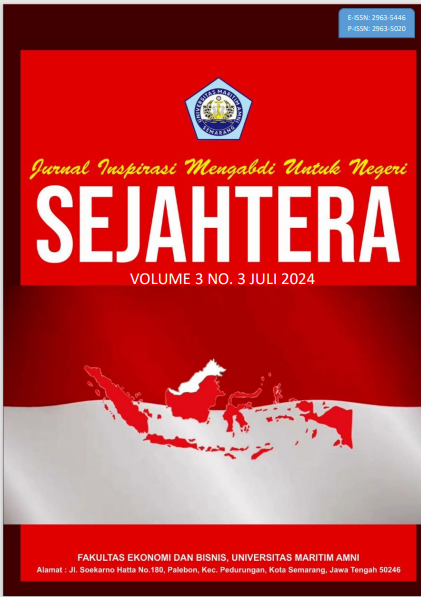Pengolahan Sampah Dapur Sisa Sayuran, Nasi Basi, Air Bekas Cucian Beras, Menjadi Pupuk Organik Cair (POC) di Desa Marga Bhakti Kecamatan Sinar Peninjauan Kabupaten Ogan Komering Ulu
DOI:
https://doi.org/10.58192/sejahtera.v4i1.3027Keywords:
Composter, Effective Microoorganism, Liquid Organic FertilizerAbstract
Indual Work Program Real Work lecture (KKN) in making this fertilizer aims to process kitchen waste in the form of residual stale rice and rice washing water into liquid organic fertilizer (POC) and reduce the volume of organic waste and improve the quality of the environment through the use of kitchen waste. The fermentation process using effective mocroorganisms and molasses is carried out throught the fermentation process using EM4 and molasess of organic waste can be converted into nutritional liquid fertilizer. The variables studied include ratio of raw materials, fermentation time, and EM4 doese. The results of the work programof individual real work lecture (KKN) show that the rresulting (POC) CAN Increas plant growth and improve soil quality with a ratio of raw materials 1:1 (waste:water), 10 days fermentation time, and 1% EM4 doese produces (POC) with quality best. Nutritional content analysis show a significant increase in nitrogen, phosporus, and potassium levels. Trial on herbal plants and vegetables showed a significant increase in growth in plants given (POC) compared to control. The use of (POC) is an environmentally friendly solution toovercome the problem of organic waste and increase sustainable agricultural productivity.
References
Al-Rawajfeh, A. E., Alrbaihat, M. R., & AlShamaileh, E. M. (2021). Characteristics and types of slow- and controlled-release fertilizers. Controlled Release Fertilizers for Sustainable Agriculture, 57–78.
Arifan, F., Setyati, W. A., Broto, R. T. D. W., & Dewi, A. L. (2020). Pemanfaatan nasi basi sebagai mikro organisme lokal (MOL) untuk pembuatan pupuk cair organik di Desa Mendongan Kecamatan Sumowono Kabupaten Semarang. Jurnal Pengabdian Vokasi, 01(04).
Bratovcic, A., Zohorovic, M., Odobasic, A., & Sestan, I. (2018). Efficiency of food waste as an organic fertilizer. International Journal of Engineering Sciences & Research Technology, 7(6), 527–530.
Gundoyo, W. (2010). Pembuatan pupuk cair organik.
Hamdiyati, Y. (2014). Pertumbuhan dan pengendalian mikroorganisme II.
Hartono, Y., Mardhia, D., Ayu, I. W., & Masniadi, R. (2020). Pengelolaan dan pemanfaatan sampah berbasis rumah tangga. Malang: Literasi Nusantara.
Nalhadi, A., Syarifudin, S., Habibi, F., Fatah, A., & Supriyadi, S. (2020). Pemberdayaan masyarakat dalam pemanfaatan limbah rumah tangga menjadi pupuk organik cair. Wikrama Parahita: Jurnal Pengabdian Masyarakat, 4(1), 43–46.
Nur, T., Noor, A. R., & Elma, M. (2018). Pembuatan pupuk organik cair dari sampah organik rumah tangga dengan bioaktivator EM4 (Effective Microorganisms). Konversi, 5(2), 5.
Shaji, H., Chandran, V., & Mathew, L. (2021). Organic fertilizers as a route to controlled release of nutrients. In Controlled Release Fertilizers for Sustainable Agriculture (pp. 231–245). Academic Press. https://doi.org/10.1016/B978-0-12-819555-0.00013-3
Downloads
Published
How to Cite
Issue
Section
License
Copyright (c) 2025 Darman Syafe’i, Henny Rosmawati, Azwar Fanani, Shara Febria Charera, Alvin Arnanda, Yeni Anggraini, Indra Putra Pratama

This work is licensed under a Creative Commons Attribution-ShareAlike 4.0 International License.







